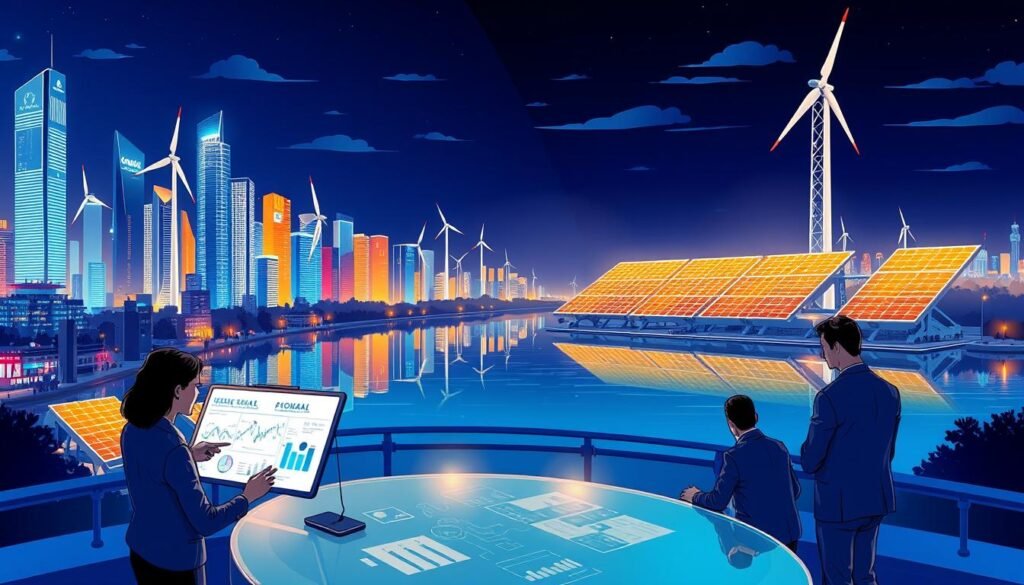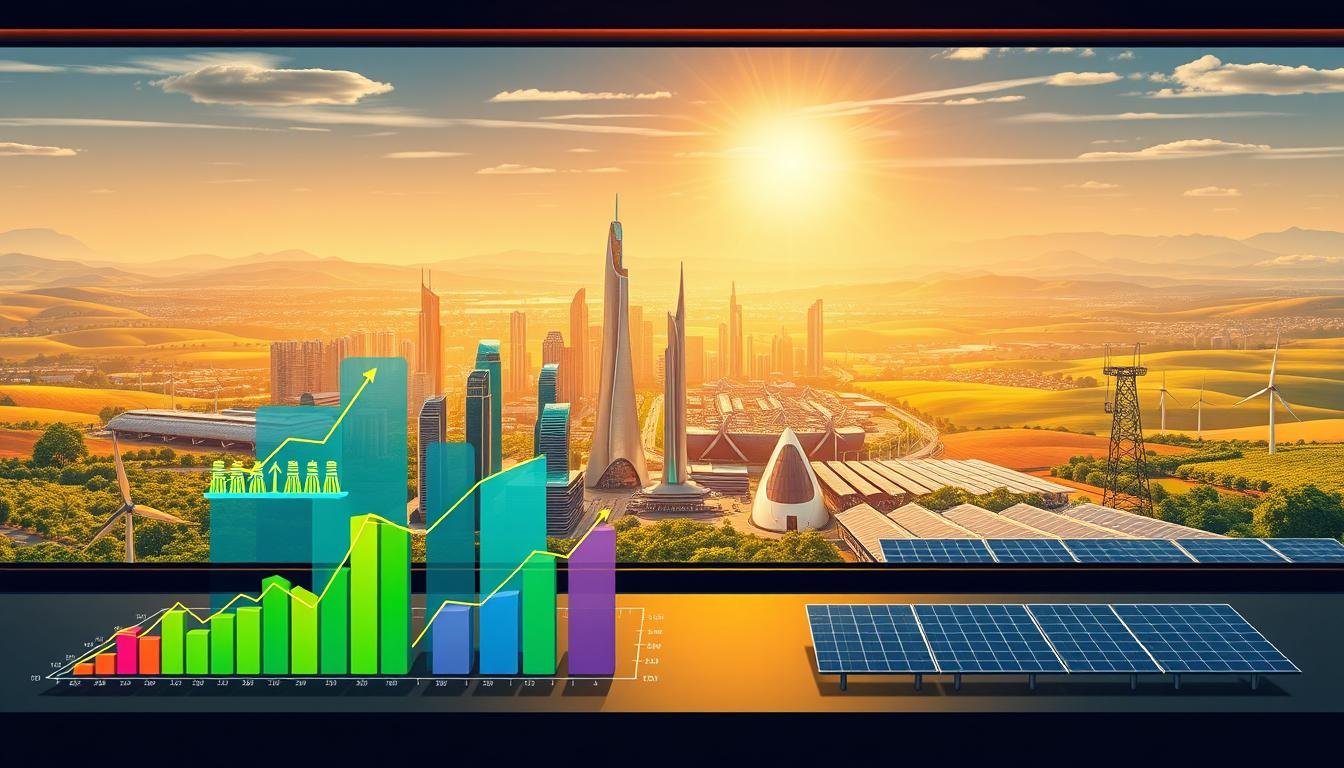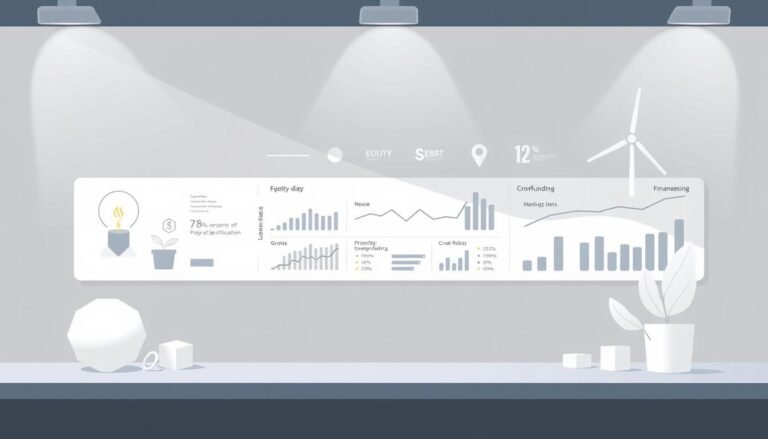Financing renewable energy projects
Can renewable energy projects really outpace traditional energy sources in funding and impact? The answer lies in the numbers reshaping our world. In 2023, global investment in low-carbon energy hit a record $1.77 trillion—a 17% jump from the year before. With renewable capacity additions soaring to 510 GW, the shift to clean energy isn’t just a goal—it’s a booming industry demanding smart financing strategies.
Project finance, combining equity and debt, powers this transition. Tax equity alone makes up 40–50% of project capital, with tools like the Production Tax Credit and Investment Tax Credit driving growth. Yet, how do these mechanisms turn ambitious solar farms or wind projects into reality? This guide explores the tools, risks, and strategies behind financing renewable energy projects in a market where coal’s dominance is fading fast.
Key Takeaways
- Global renewable energy financing reached $1.77 trillion in 2023, up 17%, signaling massive investment opportunities.
- Tax equity investors, often major corporations, use incentives like PTC and ITC to fuel 40–50% of project funding.
- By 2025, renewables will overtake coal as the top electricity source, backed by innovative financing structures.
- Project finance uses asset-backed models, balancing debt and equity to manage risks like revenue uncertainty and market competition.
- Government policies and PPA agreements are critical to securing clean energy finance and scaling projects cost-effectively.
Discover how partnerships, risk mitigation, and evolving financial tools are unlocking the future of clean energy. Let’s break down the strategies shaping the $7.3 trillion renewable capacity forecast by 2028—and why now is the time to act.
Understanding the Renewable Energy Landscape
Renewable energy financing is key to global sustainability. In 2023, clean energy investment reached $1.77 trillion. This growth is driven by demand for solar, wind, and storage. The U.S. leads, thanks to policies like the Inflation Reduction Act.
The Growth of Clean Energy in America
America’s clean energy sector is booming. Solar, energy storage, and commercial solar are top priorities. The Infrastructure Investment and Jobs Act gave $65 billion to modernize the grid.
Over 30 states have renewable portfolio standards. This means utilities must use a certain percentage of renewable energy. The U.S. is now a global leader in sustainable energy funding.
Why Renewable Energy Projects Need Specialized Financing
Renewable energy projects need a lot of money upfront. They also have long payback periods and depend on stable energy output. Traditional loans often can’t handle these risks.
That’s why specialized financing like green bonds or tax equity financing is used. These options match project lifecycles and risk profiles.
Key Stakeholders in the Renewable Energy Financing Ecosystem
| Stakeholder | Role | Example |
|---|---|---|
| Governments | Provide grants, tax incentives, and policy frameworks | U.S. Department of Energy |
| Private Investors | Supply capital for projects and equity funding | BlackRock, TPG Rise Climate |
| International Institutions | Offer cross-border funding and technical expertise | World Bank, IRENA |
| Utilities | Partner in project development and grid integration | NextEra Energy, Xcel Energy |
| Green Banks | Specialized lenders focusing on clean energy | NY Green Bank, California Infrastructure Bank |
Working together, these groups help fund clean energy projects. As the sector grows, new ways of investing in renewable energy will change global energy systems.
Types of Renewable Energy Projects Worth Investing In
The renewable energy investment world is full of choices. You can invest in solar arrays or offshore wind farms. Solar PV systems and wind turbines are well-established and reliable.
But, there are also new ideas like concentrated solar power (CSP) with energy storage. This makes power available all day. Offshore wind is more expensive but gives more energy in coastal areas.
- Solar Energy: Photovoltaic systems do well in sunny places. CSP projects use molten salt to store energy for 24/7 power.
- Hydropower: Pumped storage and small hydro projects help keep the grid stable. They also consider the environment.
- Biomass/Bioenergy: Biogas plants turn farm waste into energy. This follows the circular economy.
- Geothermal: Geothermal plants run all day. They’re perfect for areas with lots of tectonic activity.
- Emerging Tech: New tech like energy storage and green hydrogen is changing the game. It’s funded by green energy project funding from places like the World Bank.
Investors should look into combining solar with batteries or wind with hydro. This helps deal with power gaps. Community projects like energy cooperatives and Revolving Loan Funds (RLF) offer chances for smaller investments.
Spreading investments across different types makes a portfolio stronger. This is key as the market keeps changing.
Assessing Project Viability Before Seeking Financing
Before getting clean energy finance, developers must check every project detail. They need to make sure it meets lender and investor standards. This is because project finance depends on the project’s cash flows, not on outside assets.
Doing a deep dive into the project helps spot risks and chances for success. This is key for getting renewable energy financing options.
- Technical Feasibility: Engineers check if the equipment works well and if the site is right. For solar farms, they look at panel efficiency. Wind projects focus on where to place turbines. Projects that have worked before are less risky.
- Resource Analysis: They use special tools to measure solar and wind. This data helps predict how much energy the project will make. Getting this right makes lenders more confident.
- Regulatory Compliance: They need to get environmental reviews and land-use permits before starting. Also, they must get agreements with utilities to connect to the grid. This solves big problems early on.
- Financial Modeling: They break down costs into parts like hardware, labor, and extra money for unexpected things. They also look at how much money the project will make. If it can make 15-20% return, investors are more likely to help.
Projects that don’t pass these tests will find it hard to get financing. Lenders want projects with strong technical bases, good resource data, and clear rules. This hard work turns good ideas into real chances in the clean energy world.
Financing Renewable Energy Projects: Options and Strategies
Looking into renewable energy financing options means knowing how each strategy fits project goals. From starting out to running full-time, the renewable energy project funding market has plans for every need.
Key strategies include:
- Equity financing: Investors get a share of the project for their money, great for growing ventures.
- Debt financing: Loans that use project earnings as security, often from banks like the U.S. Department of Agriculture.
- Hybrid structures: Mixing equity and debt, like mezzanine financing for big solar or wind farms.
| Type | Description | Example |
|---|---|---|
| Project Finance | Loans that don’t need to be repaid from project earnings | Wind farms using cash flows as collateral |
| Grants | Money that doesn’t need to be paid back from agencies like the U.S. DOE | Community solar projects |
| PPAs | Power Purchase Agreements that secure income | Corporate partnerships with utilities |
New ways like financing renewable energy projects through crowdfunding or green bonds are becoming popular. For example, the U.S. Treasury’s Investment Tax Credit (ITC) helps with solar costs. The renewable energy project funding market now has models that mix public and private money, seen in offshore wind projects in the Northeast.
Choosing the right mix of equity, debt, and grants is key. Start by matching financing with project size and tech type. Then, think about risk to build a strong financial base.
Government Incentives and Tax Benefits
Government programs make clean energy finance easier with tax breaks and grants. Since 2005, the Investment Tax Credit (ITC) has helped grow solar power. It has also supported 250,000 jobs. The 2022 Inflation Reduction Act made things even better, making financing clean energy initiatives cheaper. Let’s look at how these incentives help lower costs and draw in investors.
Federal Tax Credits and Incentives
The Residential Clean Energy Credit gives 30% of costs for solar panels and more until 2032. This drops to 26% in 2023 and 22% in 2024. Starting 2025, only equipment with a Qualified Manufacturer (QM) code qualifies. To claim, you need to file Form 5695.
This reduces your federal taxes but isn’t refundable. Any extra credits can be used in future years.
State-Level Programs
States have their own programs like rebates and tax breaks. For example, California’s Self-Generation Incentive Program (SGIP) supports energy storage. Make sure to check local rules to use both federal and state sustainable energy funding options. Many can get special incentives.
Property Assessed Clean Energy (PACE) Financing
PACE lets property owners fund upgrades like solar or efficiency through property taxes. You pay back over the project’s life, so there’s no upfront cost. It’s available for both commercial and residential properties in certain areas.
Grant Opportunities
The U.S. Department of Energy, USDA, and EPA offer grants for new ideas and projects. Foundations like the Clean Energy Trust also fund community projects. They look for projects that match federal goals, like cutting emissions or updating grids.
Private Financing Sources and Mechanisms
Private capital is key in renewable energy financing. Commercial banks give out project loans with terms that match the life of energy projects. They often ask for collateral and proof that the project is ready to go.
Institutional investors, like pension funds, focus on green energy project funding because of ESG mandates. They look for stable returns through infrastructure funds. They usually go for big solar or wind farms because they have steady cash flows.
There are special renewable energy financing options like green bonds. In 2022, green bonds raised $136 billion worldwide, with most coming from China. Platforms that group small projects together make it easier for investors to get involved.
Crowdfunding sites also make it easier for people to invest in community solar projects. This way, even small investors can help make a difference.
Tools like credit enhancements, like guarantees from development banks, make projects seem less risky. This brings in more private lenders. For example, Argentina got a $160M credit line from the GCF-BICE, and Paraguay got a $40M facility from the GCF-AFD.
On-bill financing is another tool. It makes it easier for homeowners to get into solar energy. They pay back the loan through their utility bills.
The private sector needs to invest more in emerging markets. It should go from $135B to $1.1T every year by 2030. To get there, we need better renewable energy financing options. We also need to help investors and developers understand each other better.
Debt Financing Options for Renewable Energy
Debt financing is key for growing renewable energy financing. It supports projects like solar and wind farms. Options range from bank loans to new tools, helping developers get funds without using their own money. Let’s look at how these options boost
Traditional Bank Loans and Green Lending Programs
Commercial banks offer loans for renewable projects. They have loans for building and running projects. Banks like JPMorgan Chase and Citigroup have green programs with good terms.
These loans need solid plans and collateral, like equipment or land. The interest rates match the project’s cash flow and risk.
Green Bonds and Climate Bonds
Green bonds are big in renewable energy financing, raising over $500 billion in 2023. They attract investors who want to help the environment and make money. The International Renewable Energy Agency (IRENA) says they fund projects like offshore wind and solar farms.
Projects must meet strict standards, like the Climate Bonds Standard, to qualify.
Project Finance Structures
Project finance structures use special legal entities called Special Purpose Vehicles (SPVs). Lenders fund projects based on expected cash flows from PPAs. This way, they don’t risk their own money.
- Non-recourse loans: Lenders only claim project assets, not sponsor assets
- Asset-backed repayment: Cash from energy sales pays off loans
- Risk isolation via SPVs: Keeps sponsors safe from liability
The 1.4 GW Hornsea 2 wind farm got £2.6 billion this way. It has a 15-year PPA with National Grid.
Mezzanine Financing for Renewable Projects
Mezzanine financing fills the gap between debt and equity. It’s cheaper than equity but offers a chance for lenders to earn equity if targets are met. This mix is good for projects needing more funds than loans can provide.
For example, a big solar project might use mezzanine debt for 20-30% of costs. This way, the sponsor keeps control.
Equity Investment Structures

Equity structures are key in the renewable energy funding world. They offer different ways to get capital. Solar tax equity deals often use partnership flips, with 80% of projects choosing this method.
These setups let sponsors and investors share tax benefits in a smart way. They follow IRS rules from 2007. But, solar projects need special care in their setup.
| Structure | How It Works | Key Feature |
|---|---|---|
| Partnership Flip | Tax equity investors get 99% of tax benefits early, dropping to 5% after returns meet targets | Sponsors retain depreciation rights, aiding balance sheets |
| Joint Ventures | Multiple stakeholders co-invest in projects | Risk sharing and combined expertise |
| YieldCos | Publicly traded entities focused on steady income | Attract investors seeking predictable cash flows |
Partnership flips need careful timing. Investors put 20% upfront before building starts, then 80% after it’s done. Tax equity investors usually cover 33–66% of costs, with banks making up over 80% of the market.
The renewable energy sector grows thanks to these structures. The market moved from $20B to $50B in annual tax equity by mid-decade. This is thanks to the Inflation Reduction Act’s incentives.
- Partnership flips ensure tax equity investors get pre-negotiated returns through credits and depreciation
- Community ownership models boost local engagement while reducing financing barriers
- YieldCos enable diversification for institutional investors in green energy project funding
As the renewable energy funding market grows, these structures help manage risks and align incentives. Tax equity’s growth shows investors trust in stable returns. This is thanks to IRS rules and policy support.
Power Purchase Agreements (PPAs) as Financing Tools
Power Purchase Agreements (PPAs) are key for renewable energy financing. They provide steady income for projects and attract clean energy finance. These contracts fix energy prices, making it easier for lenders to trust.
Big names like Google and Microsoft use PPAs. They lock in energy costs for years and help new solar and wind farms grow.
How PPAs Support Project Financing
PPAs are financial backbones for financing renewable energy projects. They promise income for 15-25 years, making it easier to get loans. Developers can use the PPA as collateral.
There are special structures like Partnership Flip and Inverted Lease. They help investors and developers share risks. Utilities with good credit can also help, making loans cheaper for developers.
For example, a 25-year PPA with a utility can get projects cheaper capital. This is better than unsubsidized options.
Corporate PPAs and Virtual PPAs
Corporate PPAs let companies like Amazon buy renewable energy directly. This matches their sustainability goals. Virtual PPAs let buyers partner with projects in other areas.
This opens up new markets, like Texas. Companies can use synthetic PPAs to protect against price changes. Now, 30% of U.S. corporate renewable deals are through PPAs, says the American Clean Power Association.
Negotiating Favorable PPA Terms
Getting good PPA terms needs focus on four key areas:
- Pricing: Fixed vs. variable rates to match market trends
- Duration: 15-25 year terms preferred by lenders
- Performance: Output guarantees and curtailment rules
- Credit Support: Guarantees from investment-grade counterparties
Legal teams should check force majeure clauses and currency risks in deals across borders.
Risk Management in Renewable Energy Financing
Risk management is key for sustainable energy funding success. Projects face risks like construction delays, regulatory changes, and market shifts. For example, Sub-Saharan Africa needs $125 billion yearly in clean energy by 2030 but got only $40 billion since 2000. Smart risk strategies help close this funding gap.
- Construction risks: Cost overruns or delays can be reduced with performance bonds and EPC contracts.
- Market risks: Price swings are managed through hedging and long-term PPAs.
- Political risks: Country credit swaps and stakeholder engagement ease policy shifts.
- Technical risks: Warranties and insurance protect against tech failures.
Developing regions like SSA face higher costs—wind projects average $1,661 per kW, solar PV $2,921 per kW. Lenders use renewable energy financing tools like blended finance and risk mitigation instruments from the World Bank. Investors in renewable energy investment tackle basis risk (grid congestion) and counterparty risk via derivatives and credit guarantees. Regular performance tracking ensures projects stay on track. Proactive stakeholder communication builds trust, reducing social and environmental backlash. With these steps, projects secure funding while safeguarding returns.
Creating a Compelling Financing Package
A strong renewable energy financing options starts with a solid proposal. Begin by outlining your project’s goals, technical details, and financial forecasts in your business plan. Investors want to see how you plan to repay loans or make profits.
- Include an executive summary that highlights market demand and project scope.
- Detail technical specs, including equipment choices and installation timelines.
- Showcase financial models with revenue streams, cost breakdowns, and profit projections.
- Address risks like policy changes or technical delays with mitigation steps.
Using financing renewable energy projects tools like PACE loans and grants can boost your credibility. For example, combining SEAI grants with green bonds ensures steady funding. Use financial models to test scenarios—like fluctuating energy prices—and present worst-case outcomes. Being transparent about risks and solutions builds trust.
When pitching, tailor your content to what investors care about most. Banks focus on repayment schedules, while equity firms look for long-term returns. Show how clean energy finance mechanisms like PPAs or tax equity partnerships meet their goals. Prepare detailed due diligence materials, including permits and environmental impact reports.
Include terms for cash flow management and protections against tax credit recapture. A clear package that balances innovation with realism will stand out in competitive renewable energy financing options markets.
Case Studies: Successful Renewable Energy Financing
Real-world examples in the renewable energy project funding market show how creativity and teamwork lead to success. Here are some strategies from global leaders:
- Solar Star Projects (California): This $1.5 billion solar project used tax equity and loans to power 255,000 homes. It was set up with a Special Purpose Vehicle (SPV) to protect investors. This is a common move in financing clean energy initiatives.
- East Anglia ONE Offshore Wind Farm (UK): A £2.6 billion project got £1.9 billion in senior debt and equity from SSE, Copenhagen Infrastructure Partners, and MUFG. This mix of funding shows how big wind projects draw in investors from around the world, even with high costs.
- Denmark’s Wind Cooperatives: Community-driven green energy project funding models let Danish residents own 40% of local turbines. This approach lowered financial hurdles and boosted local economies.
- Sunrun & SolarCity: These companies started residential solar loans, making panels affordable for homeowners. Their plans showed that small-scale green energy project funding can grow big.
Lessons from these examples show the strength of partnerships and creative structures. Projects using SPVs, tax incentives, and phased funding do better than usual models. These stories prove that financing clean energy initiatives needs custom plans but offers long-term gains and returns.
Overcoming Common Financing Challenges
Getting renewable energy financing can be tough due to unclear policies and high tech risks. This part shows how to tackle these issues and make projects more viable.
addressing technology risk concerns>Emerging tech gets a lot of doubt from investors. Here are some ways to overcome this:
- Independent third-party validation of energy output predictions
- Performance-based payment clauses in contracts
- Phased project execution with milestone funding
managing policy and regulatory uncertainty>Policy changes can shake up renewable energy investment. Here’s how to handle it:
- Build flexibility into financial models to absorb subsidy changes
- Engage policymakers to stabilize regulatory frameworks
- Use hybrid funding models combining grants and loans
solutions for projects in developing markets>Below compares challenges with tailored solutions in emerging economies:
| Challenge | Solution | Example |
|---|---|---|
| High regulatory barriers | World Bank de-risking facilities | Solar projects in Kenya |
| Currency volatility | Currency hedging via derivatives | Indian utility-scale projects |
| Limited local capital | Blended finance models | Latin American wind farms |
By using these strategies, projects can lower risks and draw in financing renewable energy projects capital, even in tough spots.
Emerging Trends in Green Energy Finance
New trends in renewable energy financing options are changing how projects get funded. The Inflation Reduction Act (IRA) has helped a lot, with $27 billion for projects like energy storage and biogas. The private sector is also very interested, with $71 billion in 2024 for cleantech manufacturing.
Technology is making big changes. Blockchain and tokenization are making clean energy finance better by allowing small investors and tracking energy assets. These tools make investing easier and safer. Energy storage systems are now key in project plans, opening up new ways to make money.
Community-based sustainable energy funding is becoming more popular. Sites like Mosaic and Arcadia let people invest in local solar and wind projects. This helps more people get into clean energy investments, even in rural areas.
- AI tools from companies like GridBeyond help cut costs, drawing in investors.
- New insurance options, like weather-index policies, protect solar farms from losses.
- Hybrid financing mixes tax breaks with private loans, seen in 2023’s $622.5 billion in global investments.
But, there are still hurdles. High interest rates and supply chain problems for minerals like lithium are issues. Still, the sector is growing fast. The U.S. saw a 60% increase in renewable investments to $92.9 billion in 2024. Developers need to keep up by focusing on policy-friendly projects and using tech for funding.
The Future of Renewable Energy Project Funding
The renewable energy sector is changing fast, with new ways to fund projects leading the way. Costs are dropping, and demand is growing. By 2030, solar and wind could power 65% of the world’s electricity. But, developers need to keep up with the changing financial scene.
- ESG-focused investors now demand transparency, pushing projects to align with environmental goals
- AI tools are reducing risks by predicting energy output and optimizing project layouts
- Blockchain systems could streamline financing clean energy initiatives through smart contracts
| 2020 | Prediction by 2030 |
|---|---|
| $269.5B green bond market | $1 trillion+ annual green bond issuance |
| 85% solar cost reduction since 2010 | AI-driven financing platforms handling 40% of deals |
| $4.5T annual clean energy investment needed | Carbon credits integrated into project valuations |
By 2030, renewable energy financing will use a mix of public grants, green bonds, and private equity. Developers who use advanced forecasting and ESG metrics will get better deals. The sector must also tackle the $7 trillion in fossil fuel subsidies each year. Those who adapt to these trends will thrive as the world aims for net-zero.
Conclusion
Financing renewable energy projects is key to the global shift to clean energy. Renewable energy is set to power over 42% of the world’s electricity by 2028. This makes it crucial to find ways to fund these projects on a large scale.
Developers, investors, and governments need to work together. They must find ways to invest $19–$26 trillion in these projects. This investment should meet both financial and environmental needs.
To finance clean energy, we need to use different tools. Green bonds, tax equity partnerships, and PPAs are some of these tools. The private sector and stable policies can help manage risks like changing interest rates.
For instance, green bonds raised $500 billion in 2023. This shows they can help fill funding gaps. Public programs like PACE financing and tax incentives also help new markets.
Looking to the future, we must focus on clear policies and managing risks. Developers should update their financial plans to match changing interest rates. Investors should talk to policymakers to support these projects.
The journey ahead requires flexibility. We need to adapt to changing tax credits and balance funding sources. Working together across different sectors is also essential.
Source Links
- Project Financing in Renewable Energy: A Complete Guide – https://sustainablecapitalgroup.com/blog/project-financing-in-renewable-energy-a-comprehensive-guide/
- Foundations of Renewable Energy Project Financing – https://juliawu.medium.com/foundations-of-renewable-energy-project-financing-485c13ea1715
- Financing Projects That Use Clean-Energy Technologies: An Overview of Barriers and Opportunities – https://www.nrel.gov/docs/fy06osti/38723.pdf
- Global Landscape of Renewable Energy Finance – https://www.thefundingfamily.com/blog/global-landscape-of-renewable-energy
- Understanding the U.S. Renewable Energy Market: A Guide for International Investors – https://www.trade.gov/sites/default/files/2022-04/2022SelectUSARenewableEnergyGuide.pdf
- ACORE Blog: Expectations for Renewable Energy Finance: The Post-IRA Landscape – https://acore.org/resources/expectations-for-renewable-energy-finance-the-post-ira-landscape/
- Renewable Energy Investments | Definition, Types, Pros & Cons – https://www.carboncollective.co/sustainable-investing/renewable-energy-investments
- Financing renewable energy projects: global issues and trends – https://esfccompany.com/en/articles/construction/financing-renewable-energy-projects-global-issues-and-trends/
- PDF – https://www.wsgr.com/PDFSearch/ctp_guide.pdf
- Financing Renewable Energy Projects – https://www.thefundingfamily.com/blog/financing-renewable-energy-projects
- Financing large-scale renewable energy projects: investment loan for construction – https://esfccompany.com/en/articles/economics-and-finance/financing-renewable-energy-projects-investment-loan-for-construction/
- APEC Guidebook for Financing New and Renewable Energy Projects – https://apec.sitefinity.cloud/docs/default-source/groups/ewg/98_ewg_guideproj.pdf
- Residential Clean Energy Credit | Internal Revenue Service – https://www.irs.gov/credits-deductions/residential-clean-energy-credit
- Renewable energy tax credits: Solar, wind, and more – https://tax.thomsonreuters.com/blog/renewable-energy-tax-credits-geothermal-solar-biomass-wind-power-and-more/
- Federal Tax Credits for Energy Efficiency – https://www.energystar.gov/about/federal-tax-credits
- Key findings – Scaling Up Private Finance for Clean Energy in Emerging and Developing Economies – Analysis – IEA – https://www.iea.org/reports/scaling-up-private-finance-for-clean-energy-in-emerging-and-developing-economies/key-findings
- Green Finance LAC – Financial Mechanisms for Sustainable Energy – https://greenfinancelac.org/our-initiatives/financial-mechanisms-for-sustainable-energy/
- Green Bank Techniques – Coalition for Green Capital – https://coalitionforgreencapital.com/what-is-a-green-bank/green-bank-techniques/
- Solar tax equity structures | Norton Rose Fulbright – https://www.projectfinance.law/publications/2021/december/solar-tax-equity-structures/
- ACORE Report: The Risk Profile of Renewable Energy Tax Equity Investments – https://acore.org/resources/the-risk-profile-of-renewable-energy-tax-equity-investments/
- Project Finance for Solar Projects – https://www.stoel.com/insights/reports/the-law-of-solar/project-finance-for-solar-projects
- How to Finance Renewable Energy Projects Using Power Purchase Agreements | Firstrust Bank – https://www.firstrust.com/blog/how-to-finance-renewable-energy-projects-using-power-purchase-agreements
- PUBLIC-PRIVATE-PARTNERSHIP LEGAL RESOURCE CENTER – https://ppp.worldbank.org/public-private-partnership/sector/energy/energy-power-agreements/power-purchase-agreements
- What is a PPA? The Guide to Power Purchase Agreement – Pexapark – https://pexapark.com/solar-power-purchase-agreement-ppa/
- Risk mitigation and transfer for renewable energy investments: a conceptual review – https://www.sei.org/wp-content/uploads/2023/08/risk-mitigation-transfer-investments.pdf
- Risk management in renewable energy projects – https://farrellymitchell.com/risk-advisory-services/risk-management-in-renewable-energy-projects/
- Renewable energy projects present unique lender risks, need for oversight – https://www.dallasfed.org/research/economics/2022/0412
- 7 Savvy Strategies to Fund Your Renewable Energy Dream Project – FCIQ – https://www.fciq.ca/save-and-invest/7-savvy-strategies-to-fund-your-renewable-energy-dream-project/
- Back-Leverage Financing for Renewable Energy Projects: Key Considerations for Energy Counsel, Lenders, and Tax Equity Investors – https://www.straffordpub.com/products/back-leverage-financing-for-renewable-energy-projects-key-considerations-for-energy-counsel-lenders-and-tax-equity-investors-2025-03-25
- PDF – https://www.seai.ie/sites/default/files/publications/Community-renewables-toolkit-financing.pdf
- Real-World Examples of How Loans Drove Renewable Energy Adoption – Loans in Renewable Energy – https://www.stirlingenergy.com/case-studies-of-successful-projects/
- Project Beatrice – Project Funding Case Study – https://www.mufgemea.com/case-studies/project-beatrice/
- Renewable Energy Financing Case Studies: Lessons to be Learned from Successful Initiatives – https://cec.org/files/documents/publications/2295-renewable-energy-financing-case-studies-lessons-be-learned-from-successful-initiatives-en.pdf
- Common Challenges in Green Energy Funding and How to Overcome Them – https://m1cuso.com/challenges-energy-financing-solutions/
- Overcome Solar Project Financing Challenges: Expert Strategies – https://arka360.com/ros/solar-project-financing-challenges-strategies/
- 2025 Renewable Energy Industry Outlook – https://www2.deloitte.com/us/en/insights/industry/renewable-energy/renewable-energy-industry-outlook.html
- Energy Transition Investment Trends 2025 | BloombergNEF – https://about.bnef.com/energy-transition-investment/
- Renewables in Energy Supply: Global Trends | Investment and Finance – https://www.ren21.net/gsr-2024/modules/energy_supply/01_global_trends/03_investment_and_finance/
- Green Bonds for Financing Renewable Energy – https://www.thefundingfamily.com/blog/green-bonds-for-financing
- Renewable energy – powering a safer future | United Nations – https://www.un.org/en/climatechange/raising-ambition/renewable-energy
- PDF – https://iopscience.iop.org/article/10.1088/1755-1315/83/1/012012/pdf
- Current and Future Costs of Renewable Energy Project Finance Across Technologies – https://www.nrel.gov/docs/fy20osti/76881.pdf








